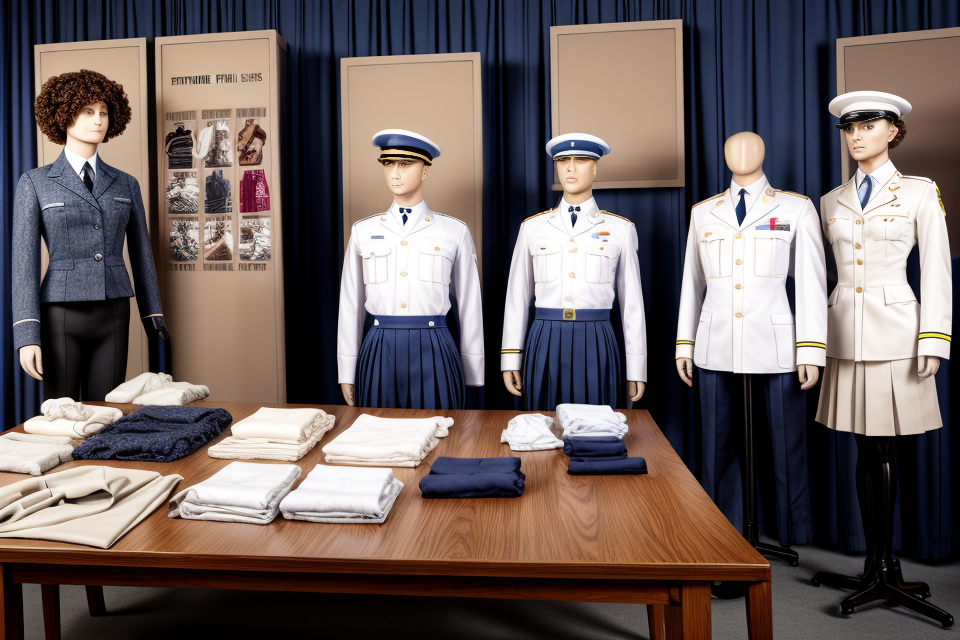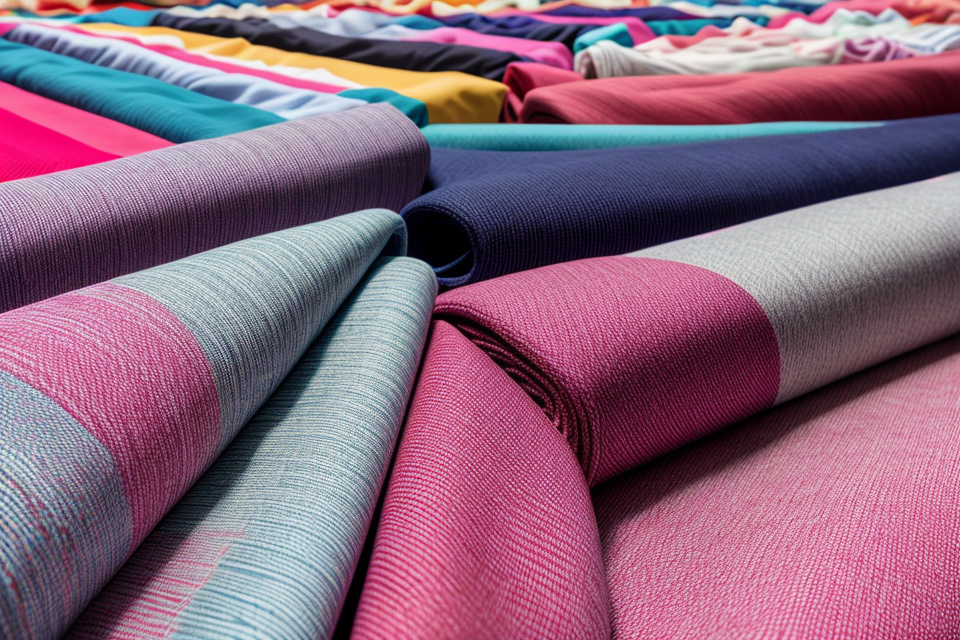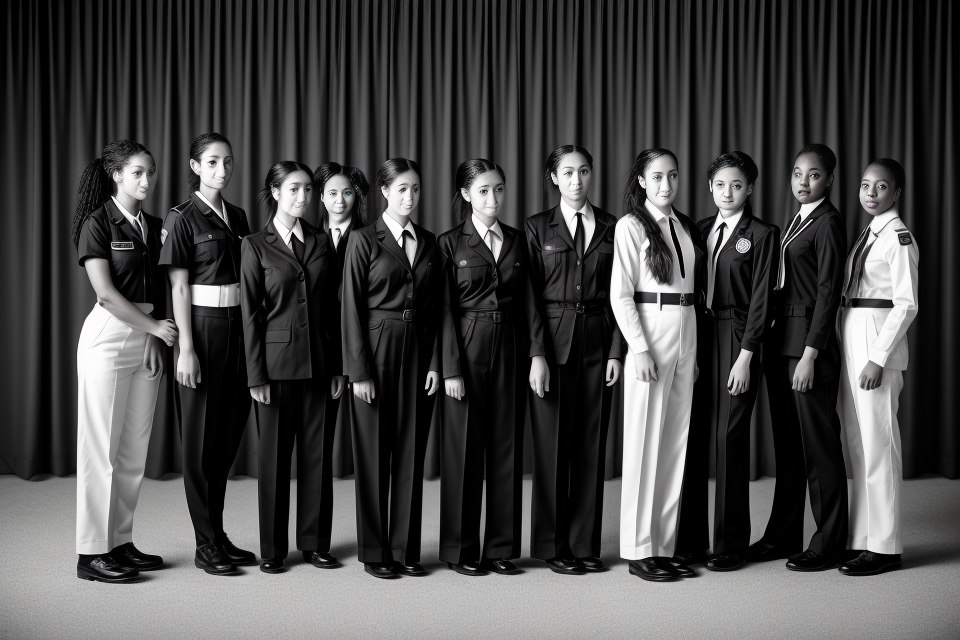
Uniforms are an essential part of many industries, from the military to healthcare, education, and beyond. But have you ever wondered about the fabrics used to make these uniforms? What materials are used to create the perfect blend of comfort, durability, and style? In this comprehensive guide, we’ll explore the different fabrics used to make uniforms, their properties, and why they are preferred for specific industries. From cotton to polyester, we’ll delve into the world of uniform fabrics and discover what makes them tick. So, buckle up and get ready to explore the fascinating world of uniform materials!
Uniforms can be made from a variety of fabrics, each with its own benefits and drawbacks. Common materials used for uniforms include cotton, polyester, nylon, and blends of these materials. Cotton is a popular choice for its comfort and durability, but it can be prone to wrinkling and can be more expensive than other options. Polyester is a synthetic material that is resistant to wrinkles and stains, but it can be less comfortable than cotton and may not breathe as well. Nylon is a strong and lightweight material that is often used for activewear, but it can be prone to tearing and may not be as comfortable as other options. Ultimately, the choice of fabric for a uniform will depend on the specific needs and requirements of the uniform and the individual wearing it.
Understanding Uniform Materials
Types of Fabrics Used in Uniforms
Uniforms are typically made from specific types of fabrics that offer a balance of durability, comfort, and functionality. In this section, we will explore the different types of fabrics used in uniforms, including natural and synthetic materials, as well as blends.
Natural Fabrics
Natural fabrics are made from fibers that are derived from natural sources, such as plants or animals. These fabrics are often chosen for their breathability, durability, and ability to wick moisture away from the body. Some of the most common natural fabrics used in uniforms include:
- Cotton: Cotton is a popular choice for uniforms due to its softness, breathability, and durability. It is also relatively inexpensive and easy to care for, making it a practical option for many workplaces.
- Wool: Wool is another natural fabric that is often used in uniforms, particularly in colder climates. It is known for its insulating properties, as well as its ability to resist wrinkles and odors.
- Linen: Linen is a lightweight, breathable fabric that is often used in summer uniforms. It is known for its ability to wick moisture away from the body, making it a good choice for hot weather.
Synthetic Fabrics
Synthetic fabrics are made from man-made fibers that are designed to mimic the properties of natural fibers. These fabrics are often chosen for their durability, resistance to wrinkles, and ability to repel water. Some of the most common synthetic fabrics used in uniforms include:
- Polyester: Polyester is a popular choice for uniforms due to its durability and resistance to wrinkles. It is also relatively inexpensive and easy to care for, making it a practical option for many workplaces.
- Nylon: Nylon is a strong, lightweight fabric that is often used in uniforms that require a lot of movement, such as athletic uniforms. It is known for its ability to stretch and recover, as well as its resistance to water.
- Spandex: Spandex is a stretchy, elastic fabric that is often used in uniforms that require a tight fit, such as dance or gymnastics uniforms. It is known for its ability to move with the body, providing a comfortable and flexible fit.
Blends
Blends are fabrics that are made from a combination of natural and synthetic fibers. These fabrics offer the best of both worlds, combining the breathability and comfort of natural fibers with the durability and resistance to wrinkles of synthetic fibers. Some of the most common blends used in uniforms include:
- Cotton-polyester: Cotton-polyester blends are a popular choice for uniforms due to their durability, ease of care, and comfortable fit. These blends often offer the best of both worlds, combining the softness of cotton with the wrinkle-resistance of polyester.
- Polyester-cotton: Polyester-cotton blends are another popular choice for uniforms. These blends offer the strength and durability of polyester with the softness and breathability of cotton, making them a versatile and practical option for many workplaces.
Factors Influencing Uniform Fabric Selection
Durability
Uniform fabrics must be durable enough to withstand regular wear and tear. Strength and resistance to wear and tear are essential factors in the selection of uniform fabrics. Fabrics that can withstand repeated washing and drying without fading or wearing out are preferred.
Comfort
Comfort is a crucial factor in the selection of uniform fabrics. Uniforms are worn for extended periods, and comfort is essential to ensure that the wearer can move freely and maintain their focus on their work. Breathability, softness, and flexibility are crucial aspects of comfortable uniform fabrics.
Appearance
The appearance of uniform fabrics is an essential factor in their selection. Uniforms represent the organization, and their appearance reflects the professionalism of the organization. The uniform fabric must retain its color and shape even after multiple washes. Uniforms that shine and have a lustrous appearance are preferred, as they create a positive impression on customers and clients.
Professionalism
Professionalism is a crucial factor in the selection of uniform fabrics. The fabric must be perceived as professional and meet the requirements of the uniform code. The uniform fabric must project a sense of authority and credibility, reflecting the professionalism of the organization. The uniform fabric must also meet any specific requirements outlined in the uniform code, such as flame resistance or anti-static properties.
Popular Uniform Fabrics
Cotton
Cotton is a widely used fabric in the production of uniforms due to its numerous advantages. It is known for being breathable, comfortable, and affordable, making it a popular choice for both employees and employers. However, there are also some disadvantages to consider when using cotton as a uniform fabric.
Advantages
- Breathable: Cotton is a highly breathable fabric, which makes it an excellent choice for uniforms that will be worn for extended periods. The material allows air to circulate around the body, keeping the wearer cool and comfortable.
- Comfortable: Cotton is a soft and lightweight fabric that is comfortable to wear. It is gentle on the skin and does not cause irritation, making it an ideal choice for uniforms that will be worn for long hours.
- Affordable: Cotton is an affordable fabric, making it a popular choice for uniforms. It is widely available and can be produced in large quantities, which helps to keep costs low.
Disadvantages
- Not durable: One of the main disadvantages of using cotton as a uniform fabric is that it is not very durable. The material is prone to tearing and can easily become damaged, especially if it is not cared for properly.
- Can wrinkle easily: Cotton is a fabric that wrinkles easily, which can make it unsuitable for some uniform applications. Wrinkles can give the impression of a poorly made or unkempt uniform, which can reflect poorly on the business or organization.
In conclusion, cotton is a popular choice for uniform fabrics due to its many advantages, including its breathability, comfort, and affordability. However, it is important to consider the fabric’s durability and tendency to wrinkle when deciding whether it is the right choice for a particular uniform application.
Polyester
Polyester is a synthetic fabric that is commonly used in the manufacture of uniforms. It is known for its durability, wrinkle-resistance, and ease of cleaning. However, it has some disadvantages as well.
Advantages:
- Durable: Polyester is a strong and long-lasting fabric that can withstand frequent wear and tear.
- Wrinkle-resistant: The fabric has a natural resistance to wrinkles, which makes it easy to maintain and wear.
- Easy to clean: Polyester is a material that can be easily cleaned using water, and it is resistant to stains, making it a popular choice for uniforms.
Disadvantages:
- Can be hot to wear: Polyester is a synthetic fabric that can trap heat, making it uncomfortable to wear in hot weather.
- Not as comfortable as cotton: The fabric can be rough and uncomfortable to wear, especially for extended periods. Additionally, it does not breathe well, which can cause sweating and discomfort.
Nylon
Nylon is a synthetic fabric that is commonly used in the manufacture of uniforms. It is a strong and durable material that is also lightweight, making it ideal for active wear.
- Advantages:
- Lightweight: Nylon is a lightweight fabric, which makes it ideal for uniforms that need to be worn for extended periods. This lightweight quality also makes it easy to move around in, which is essential for uniforms that require a lot of physical activity.
- Durable: Nylon is a strong and durable fabric that can withstand a lot of wear and tear. This makes it ideal for uniforms that need to be worn frequently and washed regularly.
- Water-resistant: Nylon is a water-resistant fabric, which makes it ideal for uniforms that need to be worn in wet or humid conditions. This property also makes it easy to clean and maintain.
- Disadvantages:
- Can be noisy when moving: One of the main disadvantages of nylon is that it can be noisy when moved. This noise can be particularly noticeable in environments where quiet is essential, such as in a library or museum.
- Can stretch: Another disadvantage of nylon is that it can stretch over time. This stretching can cause the uniform to lose its shape and become uncomfortable to wear.
In conclusion, nylon is a popular choice for uniforms due to its lightweight, durable, and water-resistant properties. However, it may not be the best choice for uniforms that require quiet movements or need to maintain their shape over time.
Spandex
- Stretchy: Spandex is known for its ability to stretch and adapt to different body shapes and sizes, making it a popular choice for uniforms that require a snug fit.
- Comfortable: The stretchy nature of spandex makes it comfortable to wear, even for long periods of time. This is particularly important for uniforms that are worn daily, such as those worn by athletes or healthcare workers.
-
Flexible: Spandex is a highly flexible fabric, which makes it ideal for uniforms that require a lot of movement. For example, spandex is often used in the manufacture of dance uniforms.
-
Not as durable as other fabrics: Spandex is not as durable as other fabrics, such as cotton or polyester. This means that it may not be the best choice for uniforms that are exposed to rough conditions or that require frequent washing and drying.
- Can pill easily: Spandex is a delicate fabric that can pill easily, which can affect the appearance of the uniform. This can be particularly problematic for uniforms that require a professional appearance, such as those worn by business executives or public servants.
Choosing the Right Fabric for Your Uniform
Factors to Consider
When choosing the right fabric for your uniform, there are several factors to consider. These include the activity for which the uniform will be used, the design of the uniform, and the budget for the project.
Activity
The physical demands and environmental conditions of the activity for which the uniform will be used are important factors to consider when choosing the right fabric. For example, if the activity involves a lot of physical exertion, the fabric should be comfortable and breathable. If the activity takes place in a hot environment, the fabric should be lightweight and moisture-wicking.
Uniform Design
The design of the uniform, including the cut and style, can also impact the choice of fabric. For example, a uniform with a more formal cut may require a heavier, more durable fabric than a more casual cut. The style of the uniform may also impact the choice of fabric, as certain fabrics may be better suited for certain styles.
Budget
Finally, the budget for the project is an important factor to consider when choosing the right fabric for a uniform. The cost of the fabric itself, as well as the production costs, should be taken into account when making a decision. It is important to find a balance between choosing a high-quality fabric that will last and fitting within the budget for the project.
Tips for Selecting the Perfect Fabric
Selecting the perfect fabric for your uniform is crucial to ensure both style and functionality. Here are some tips to help you make the right choice:
- Consult with professionals:
- Designers
- Textile experts
Collaborating with designers and textile experts can provide valuable insights into the latest trends, performance requirements, and industry standards. They can offer recommendations based on your specific needs and help you navigate the wide range of options available.
- Consider feedback:
- Employees
- Customers
Gathering feedback from employees and customers is essential to ensure that the chosen fabric meets their needs and preferences. This feedback can help you identify important factors such as comfort, durability, and style, which are crucial for a successful uniform design.
- Order samples:
- Test different fabrics
- Compare quality and cost
Ordering samples of different fabrics is a practical way to test their quality and cost-effectiveness. By comparing various options, you can evaluate their strengths and weaknesses, including their texture, breathability, moisture-wicking ability, and resistance to wrinkles. This hands-on approach allows you to make an informed decision based on real-world testing.
FAQs
1. What fabrics are typically used to make uniforms?
Uniforms can be made from a variety of fabrics, including cotton, polyester, nylon, and blends of these materials. Cotton is a popular choice because it is comfortable, breathable, and durable. Polyester is also commonly used because it is a synthetic material that is easy to clean and resistant to wrinkles. Nylon is often used for its strength and water-resistant properties. Blends of these materials are also commonly used to create uniforms that are both comfortable and durable.
2. Are there any specific types of fabrics that are recommended for certain types of uniforms?
Yes, the type of fabric used for a uniform will depend on the specific requirements of the uniform. For example, uniforms that are worn for physical activities such as sports or law enforcement may require a fabric that is more breathable and moisture-wicking. Uniforms that are worn for formal occasions may require a fabric that is more formal and durable. The specific requirements of the uniform will dictate the type of fabric that is most appropriate.
3. How should I care for my uniform to ensure it lasts as long as possible?
To ensure that your uniform lasts as long as possible, it is important to follow proper care instructions. This may include washing the uniform in cold water, avoiding the use of bleach or other harsh chemicals, and air-drying the uniform rather than using a dryer. It is also important to have the uniform professionally cleaned on a regular basis to remove any dirt or stains and to prevent damage to the fabric. Following these guidelines will help your uniform look its best and last longer.
4. Can I wear my uniform outside of work?
Whether or not you are allowed to wear your uniform outside of work will depend on your company’s policies. Some companies allow employees to wear their uniforms outside of work as a way to promote the company and its products or services. Other companies may have stricter policies that prohibit the wearing of uniforms outside of work. It is important to check with your company’s policies before wearing your uniform outside of work.


